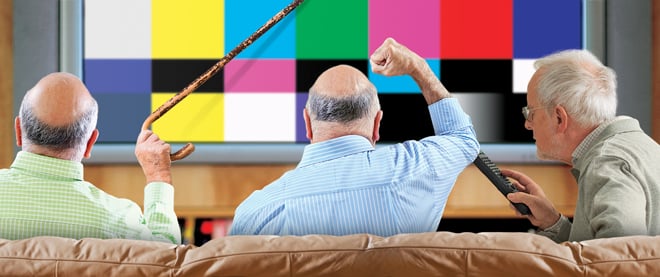Television’s mid-life crisis
A show can be a hit, but if its viewers are over 49, chances are it’ll get the axe
Shutterstock; Getty Images; iStock; Photo Illustration by Sarah MacKinnon
Share

A television show can get ratings and still be a failure. That’s what viewers of Harry’s Law discovered, to their chagrin, when the series was cancelled by NBC even though it was the network’s most popular scripted show. The drama, which earned an Emmy nomination for star Kathy Bates, had an average of eight million viewers per episode, compared to four million for the network’s flagship show The Office, and fewer than that for renewed shows like 30 Rock and Parenthood. But most of Harry’s Law’s viewers were over the age of 50, and in modern TV, advertisers only pay high prices for viewers between the ages of 18 and 49. “It’s just harder to monetize that older audience,” NBC president Robert Greenblatt bluntly explained after cancelling the show. “Any rational person would argue a hit show with an older audience is better than no hits at all,” says Rick Ellis, founder of the news site All Your TV. “But broadcast television executives are not always known for their rational behaviour.”
Young adult viewers have been TV’s target demographic for decades, because they’re thought to have less brand loyalty and more disposable income. That didn’t make as much difference back when television shows reached a broader audience: if a show was a hit with old people, like The Golden Girls, it usually “brought in enough younger viewers to be viable,” explains Brian Lowry, chief TV critic for Variety. But today, Ellis says, the young audience is “fragmenting and moving to cable,” so different generations are often watching completely different shows. “The problem with the broadcast networks chasing the younger demo is that most of the time they aren’t reaching them,” Ellis adds.
That means there are an increased number of shows only older people watch, and advertisers don’t consider those shows to be hits. Jesse Stone, Tom Selleck’s series of TV detective movies, brought in a large audience of almost 13 million people—but only 10 per cent of those people were under 50, and the series was cancelled. So was CSI: Miami, which remained very popular with total viewers but looked mediocre in the 18-to-49 age group, or the “key demo” as show business trades call it. The need to attract young people also affects the casting of shows that stay on the air: shows like NCIS surround older stars with mostly young casts, and the recent revival of Dallas gives most of the screen time to a new cast of young, pretty people.
Lowry says the demand for youth appeal often puzzles TV creators, who don’t care about demographics and “simply want people to see their work.” On the other hand, TV’s youth obsession may have improved the quality of the shows we see. “The search for younger viewers has kept some shows on the air,” Ellis says, pointing to critically acclaimed shows like Community and Parks & Recreation that got low ratings, but have been renewed due to their young audiences. Going by total viewers, the most popular shows on television are almost all mystery and reality shows, but the 18-to-49 demographic watches more critically respected shows like The Walking Dead and Modern Family. Thanks to the 18-to-49 obsession, TV creators no longer have to reach a broad audience; they’re free to make quirky shows for the young.
Still, older viewers don’t like being told they are, as Lowry puts it, “perceived to be worthless from a sales perspective.” And many people are questioning the relevance of the key demographic at a time when, thanks to DVR, young people often don’t watch the commercials. Ellis thinks eventually advertisers will have to accept that young people are not TV’s core audience: “Ad agencies are going to be forced to expand their target demo, because the broadcast networks will still have the largest audience in television. It will just be an older one.” But it could be that as the TV audience gets older, 18- to 49-year-old viewers get more valuable due to their scarcity. Lowry says today’s ad buyers place a premium on young adults “precisely because they are more elusive.” Lowry thinks networks need to explain the situation more effectively to angry older fans, but admits this is going to be difficult. “There’s no way to describe the process without smacking of ageism,” he says. “Which, of course, it is.”